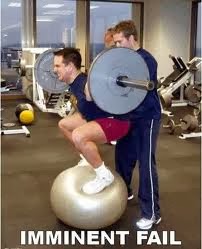Any sport comes with an inherent level of risk. Anyone who has played contact sports knows that concussions at some point in their career are a virtual certainty. Even non-contact sports like basketball, soccer and baseball carry with them the possibility of a torn ligament from sudden change of direction, or joint risks, such as subluxation or torn labral tissues; from the application off-balance forces. Many athletes play the sports they love, accepting these risks for the chance to win a championship or graduate to the professional ranks.
But where does that leave exercisers who are trying to lose weight or add muscle tone (the two most common goals of the average personal training client)? What purpose does a stability ball, barbell, back-squat serve[3]? It is virtually impossible to spot and adds uneeded complexity to an exercise that a minutiae of the population actually does flawlessly (the squat) on solid ground. You risk your client's health and well-being for something that looks impressive, but actually serves little to no purpose. I would not give this exercise to any of my athletes or clients because it has no application in sport or the real world. I also question the wisdom of introducing Jill or Joe Average to the Olympic lifts (unless they request it from you or show interest of their own volition). The clean, the snatch, and the clean and jerk are beautiful lifts when done properly. But these lifts are restricted to power sport athletes for good reason: 1) The average exerciser doesn't really the NEED power that these offer, 2) Power training for Joe Blow can be done under less technical and more controlled circumstances (dumbbells, kettlebells, body-weight, etc.), 3) This usually involves a lot of weight if you are seriously training for power. If they haven't MASTERED perfect form in the foundational lifts (Squat and Deadlift), then there is no way I am going to risk their spine, shoulders and knees, on lifts that are super technical and not applicable to their goals. It just doesn't make sense.
[2] [3]

I am all for changing up a routine and touching on as many of the foundational pillars of fitness as possible...but not all in one exercise. Resistance training, cardio training, balance training, and flexibility training are all an essential and supplementary part of any training program, and proper periodization of a program is not to be taken lightly (ie. first time exercisers should NEVER jump in to power training before progressing through: foundational movement, endurance, hypertrophy and strength training first).
Let's be honest, an effective workout program is founded on variations of 4 basic movements meant to improve strength: squat, push, pull, (vertical) press; consider it to be like a compass with each direction representing the direction of force. It takes months, if not years, to master perfect form in each discipline. Balance and coordination can then be added to variations of the exercise in a supplementary manner, but by no means should balance be done under extreme weight as stabilizer muscles are small and fatigue quickly. Exercises that are designed for power or strength, should be respected for their purpose. Instability saps power potential and will change the focus of your lift, effectively detraining the power athlete.
So before you want to do a show-stopper exercise at the gym, give a thought to the purpose of it and take a moment to weigh the risk versus the reward. Are complex olympic lifts really what your weight-loss client's program is lacking? Have you actually mastered the foundational lifts and are ready to progress to instability training under load? Are you using the exercise for its intended purpose? These are all questions you should ask yourself before going in to your next workout. Train with as much purpose as you do passion.
- Brendan Rolfe
Personal Training Specialist, Nutrition & Wellness Specialist, BA, DipA
Photo credits
1 http://www.liftingrevolution.com/dangerous-exercises-for-women-beginners-and-why-not-to-do-these/2 http://muscle.iuhu.org/2014/01/must-watch-videos-with-hilarious-but-dangerous-things-which-gym- newbies-do-how-not-to-perform-gym-exercises-at-various-machines/
3 http://www.reddit.com/r/Fitness/comments/1c8z8t/what_is_the_funniest_workout_you_have_ever_seen/


No comments:
Post a Comment